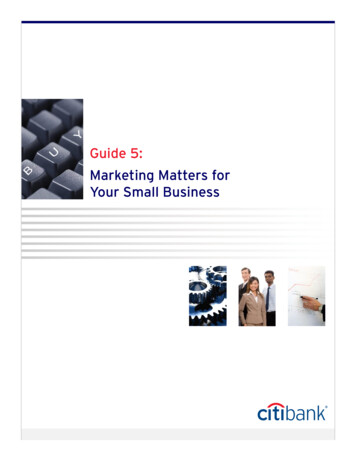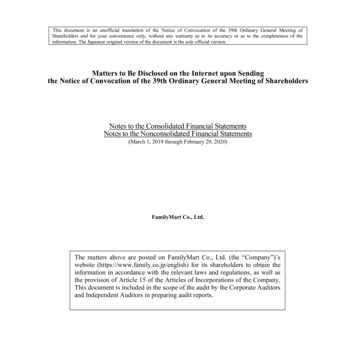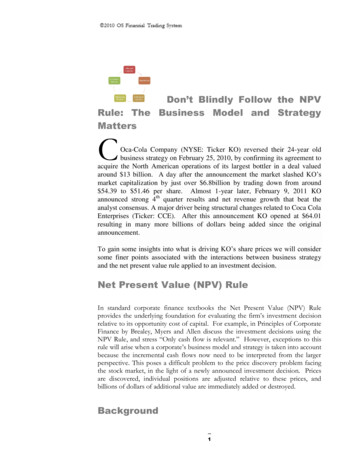
Transcription
Guide 5:Marketing Matters forYour Small Business
Guide 5 - Marketing Matters for Your Small Businessn INTRODUCTIONWelcome to the Citibank Small Business information guide series. This is one of tenguides that have been developed just for you, a person who is thinking about startinga small business or who has made the commitment to start one. It is targeted topeople who are considering starting a small business as well as small business ownerswho want to learn more about successful strategies and skills. Citibank worked with ateam of small business owners like you to develop, write, and produce this series. Allof us know how important it is to have clear and concise information to make smartbusiness decisions. Our goal is to share experiences about the dynamic, exciting smallbusiness community.The successfulentrepreneurunderstands howmarketing leads togrowth and profit.Marketing Matters for Your Small Business will help you to: learn what marketing is. understand how good marketing works to promote growth and profitability inyour business. learn basic marketing strategies for small business. identify marketing opportunities suited to your business model. compare advantages and costs of marketing opportunities. create a marketing plan for your business.If that sounds like a challenge, relax. You’ll soon realize that the ideas outlined inMarketing Matters for Your Small Business are not difficult. In fact, many newbusiness owners find that marketing is interesting and fun.n OverviewAlways remember that good businesses don’t just happen. They are planned to besuccessful and marketing plays a major role. Marketing includes many differentGuide 5: Marketing Matters for Your Small Businesspage
activities. All of them aim to sell a product or service, directly or indirectly. These arethe basic marketing categories: market research and strategy — to learn more about a business and theclimate in which it operates. It involves surveys, focus groups, questionnairesand analyses to define a target audience, competition, pricing, and more. Theresults help the business choose a name, design a logo, and complete otherbranding efforts. marketing communications — tactics used to give information about thebusiness to target customers. Examples include a website, catalog, price list,direct mail, demonstrations, samples, and more. Related efforts to expandthe business reach are also in this category, including partnerships withdistributors, wholesale agreements, and other arrangements that help potentialcustomers locate and buy your product. Marketing includesa wide range ofactivities andapproaches. Onesize doesn’t fit all.advertising and public relations — ads are paid announcements that deliverproduct or service information to inform target customers; examples includenewspaper and yellow pages ads. Public relations activities are provided bythe business, without charge to customers, or to outlets that publish theinformation; examples include news releases, press events, newsletters,demonstrations, and programs designed to create customer awareness of yourproduct or service.Can you believe that marketing encompasses so many different types of activities? Youmay be surprised to learn just how important Marketing Matters for Your SmallBusiness can be.Take a few moments to page through this guide now. You will see that marketing reallylets you put your best business foot forward! If you are good at math, you can developmarket surveys and comparative analyses. If you enjoy technology, you can use it tostreamline your operations, improve your customer service, and/or set up a detailedcustomer database. If you’re a strong writer, you can create press releases, fact sheets,newsletters, or other information resources to share the good word about your business.Guide 5: Marketing Matters for Your Small Businesspage
Marketing allows you to make the most of your skills to build your business, betterand faster.Equally important, while you can use your own skills for the marketing activities youenjoy, take advantage of the many other available resources too. There are excellentmarketing professionals available on the Internet and in communities across America.Their services can be quite cost-effective. Local or regional business developmentorganizations sometimes provide marketing services free or at a minimal cost. There arealso several excellent national volunteer organizations that provide free or low-cost helpto new businesses. The Service Corps of Retired Executives (SCORE) is an excellentexample. Refer to the Additional Resources on page 21 for others.One of the most exciting things about marketing is that there are examples of iteverywhere.Take note ofmarketingresources, locallyand nationally, inbuilding your plan.Stop. Look. And Listen. Train yourself to look carefully at the businessesaround you. Which ones seem to be doing a good job of marketing? What can youlearn from them?But first, get ready to learn all about marketing by making a copy of all the worksheetsin this guide. As you work through the activities in this guide, you can create your ownMarketing Resources Guide. Clip and save good examples of various marketing efforts.Write your own ideas and notes on each clip. Use a 3-ring binder with tabs to organizeGuide 5: Marketing Matters for Your Small Businesspage
the various marketing categories. You’ll be amazed at how useful this clip collection isas you continue to build your own new business marketing skills.I. Who Needs Marketing? Why?Q: Who needs marketing?A: Everyone who plans to grow a business.Q: Why do I need to market my business?A: With many possible competing businesses and many potential customers towin over, marketing is important in order to get your name out in the businesscommunity as well as to differentiate your product or service. Example: You’re planning to open a new dog kennel in your community.Market research shows you that:You must marketyour product orservice in a waythat distinguishesyou from others. there are 20,000 people within a 15 - 20-minute drive from your location. there are 2 kennels nearby.HoursPrice Per DayAdDog House6am-8 pm 30We love your dog asmuch as you doThe Pampered Pooch7:30am-7:30pm 50The pedigreed place Ask Yourself:What conclusions can I make from this information? No kennel loves my dog as much as I do. Would my dog be welcome at The Pampered Pooch if he’s not pedigreed? Would an hourly rate work? A weekly rate? Neither ad tells how much exercise a dog would get. Neither ad says whether you can bring your own dog food. Neither ad tells how many people work at the kennel. Neither gives the training of the workers. Neither talks about safety or sanitation issues. Neither gives the name of the owner. Are the hours suitable for commuters? Neither mentions if it also provides grooming or veterinarian servicesGuide 5: Marketing Matters for Your Small Businesspage
How would you write an ad for your new kennel? Create it in the space below.Notice how even a quick study of two ads helped you focus your thinking. That is thegoal of market research. Another Example:What’s in a name? Plenty. Look over this list. Draw a line from one column to theother to match each business with its name.Businessesa. knitting storeb. online catering companyc. boat and fishing gear stored. restaurante. children’s clothing catalogf. photography studiog. car dealerh. dineri. cosmetics storej. hardware storek. beauty salonNames1. Joe’s Place2. In Focus3. Kathy’s Kidstuff4. A Good Yarn5. Morrison’s Cement & Hardware6. E-meals.com7. Schaeffer’s8. Portside9. Reddy’s Restaurant10. Looking GoodNotice anything? Some business names let potential customers know what productor service the business provides. Others don’t. It’s tempting to name your businessimmediately, but it could be wiser to wait until you’ve completed your market research.Ask questions that will help you identify what your potential customers are looking for,then name your business to get their attention.Guide 5: Marketing Matters for Your Small Businesspage
Ask Yourself: Did I ever try out a new business because the name interested me? Did I ever avoid a business because of its name? When I’m looking to find a business for a specific purpose, such as to do roofrepairs, how does the name of a business influence my decision to contact abusiness?II. Start with Market ResearchTake some good advice from successful business owners. The time and energy youspend upfront studying an industry and your potential customers is time very wellspent. It prepares you to recognize challenges and take advantage of opportunities.Do thoroughmarket researchon the industryyou want to enter.Think of it in sports terms. Sports consist of a series of situation analyses. The coachesand players study other teams to understand their strengths and weaknesses and thendevelop plays to improve the chances for scoring and winning. As a new businessowner, you are the coach. Your market research is your first step to success.First, a Situation AnalysisA situation analysis is an overview study of the industry you are planning to enter.This allows you to get a clear idea of how businesses, like the one you are considering,operate. You may be able to find the facts you need through industry publications oron the Internet. Refer to the Additional Resources at the back of this guide. Example: You are considering buying the franchise rights to market a home securityalarm system in your community. Your situation analysis may show that the majorexpenses in running that type of business are salaries for installers and customer servicerepresentatives. It could also show that your community is served by three alarmcompanies, or none. All of this information can help you make an informed decisionabout whether, when, and how to buy the franchise.Guide 5: Marketing Matters for Your Small Businesspage
Ask Yourself: What, if anything, could I do to make my alarm franchise succeed even withthree competitors? What marketing strategies could help create a positive image for my new alarmsystem? Do I want to adapt my plan to focus on a certain type of customer, such asschools or storage areas, where there is less competition?It’s clear that a situation analysis is very helpful. It helps you learn more about the size,growth rate, sales, major players, and other elements of an industry. Refer to Guide 3:Building a Business Model for Success. Then, use this chart to do a basic analysis onthe industry you have identified as part of your business model.Study competitorsand be realisticabout how youwill fit into themarketplace.Note: Some of the items on this list may not be relevant to the business idea you areexploring.My Market AnalysisIndustry: Date:General descriptionCOMMENTSHistorySize of market, # ofcustomersSegments, groups withinthe marketGrowth rateInnovation rateGuide 5: Marketing Matters for Your Small Businesspage
Life cycleMarginsMajor players, potentialcompetitionTurnoverMajor strategic groupsIndustry Value Chain(refer to businessmodel, Guide 3)Barriers to entryConcentrationAdvertising intensity,competitionAverage firm sizeLabor intensityCapital intensityRead as much as you can about the new business you are planning. Some things thatmay be challenges for other people may be no problem for you. The opposite is alsotrue. Be honest with yourself. If people skills are not your strength, but the industryrequires strong people skills, think about how you will manage that issue. Maybe youGuide 5: Marketing Matters for Your Small Businesspage
can hire supervisors who have excellent people skills so you can focus on using youroutstanding financial management skills to run the business.Remember: Your goal is not to become a specialist at everything involved in managing abusiness. Instead, it is to match up your skills with an industry where you can use themfor success or manage others who can handle those responsibilities. Refer to Guide2: Developing Your Small Business Idea for more information. Ask Yourself: What did I learn about my business idea that was a surprise? What did I learn that encourages me to continue with my new business idea? Did I learn anything that makes me rethink my business model?Take a look atyour potentialcustomers. Howwill you best servethem?Take a Good Look at Potential CustomersOnce you have identified an industry that seems to fit your business goals, take a closerlook at your potential customers. Example: Linda decided to start designing and manufacturing clothes for plus-sizewomen.Type of Business: Retail Store, Plus-Sizes for WomenWho are my Potential Customers?CustomerType Niche/SegmentBenefits toNicheDistributionChannel(s):How will I reachcustomers?Size ofMarketDecidingFactorsInfluences onbuying?Other FactorsCost/customer,service costsBaby boomersBusy, wantconvenience andquality fashionsRetail savvy,want easy careAlterationsneededCareerwomenBusy, wantconvenienceand quality,professionalimageRetail store/s,InternetFocusedmarketWilling to payfor quality, wanteasy travel, careAlterationsneededGuide 5: Marketing Matters for Your Small Businesspage 10
RecentlyretiredHave time to shopRetail store(s)FocusedmarketPrice-sensitive,need fewerclothes thanwhile workingAlterationsneededYoungmothersBusy, concerned aboutfashion and carecomfortAthleticwomenHave few choicesfor good-looking,versatile fashionsSpecialty shopsFocusedmarketWantconvenience andgood looksOlder womenMay haveunique needsfor convenientopenings, fabricsSpecialty shopsFocusedmarketFind shoppingdifficult, manyfashions hard toget on/offAlterationsneeded Ask Yourself: How did this analysis help Linda identify the characteristics of her potentialA chart such asthis one allowsyou to analyzecustomers andcompare niches.customers? How can she use this information to make key decisions about design,production, distribution, and other important issues?See how a closer look at your potential customers can help you. Again, refer to Guide3: Building a Business Model for Success and your business model. Use this chart or create your own with a computerized database. There are several models availableonline.Guide 5: Marketing Matters for Your Small Businesspage 11
Type of Business:Who are my Potential Customers?CustomerType Niche/SegmentBenefits toNicheDistributionChannel/s: Howwill I reach them?Size ofMarketDecidingFactorsInfluences onbuying?Other FactorsCost/customer,service costsCheck Out Your CompetitionMost people who are planning to start a new business are optimists. That’s certainlya good and useful quality. However, now’s the time to balance that optimism withan objective look at your competition. Be sure to look for the best qualities of yourcompetitors, as well as their weaknesses.Reminder: Think of yourself as a sports coach. If you only developed plays that workedagainst your opponents’ weaknesses, your team would not be prepared to meet theirstrengths!Guide 5: Marketing Matters for Your Small Businesspage 12
Example: Use this grid or create a similar one on your computer.Check Out the CompetitionCompetitorAddress, efits,advantagesWeaknessesHow can Icompete?What can I dobetter?Competitor #1Competitor #2Competitor #3Competitor #4 Ask Yourself: What did I learn about my competition? How or why will I have the advantage over my competition?Learn From Your Potential CustomersMost people enjoy sharing their opinions. Use that to your advantage. Once you haveidentified your potential customers and likely competition, do some detailed marketsurveys to compare your ideas with what potential customers have to say. This realitycheck can be a lifesaver. It can help you avoid making decisions that are expensive orunnecessary. For example, suppose you were budgeting for the cost of pick-up andGuide 5: Marketing Matters for Your Small Businesspage 13
delivery of dogs to your new kennel and your market survey showed that your potentialcustomers would rather deliver and pick-up their dogs themselves. Without the marketsurvey, you could have created a business expense that was unnecessary.There are many free or inexpensive market survey forms online. Refer to one or more ofthe references on page 21 to find forms that work for you. Or look at a wide variety offorms, then choose questions from them to develop your own market research form.Consider all the ways you can contact potential customers: attend community functions mail a questionnaire to members of a club or neighborhood distribute free samples and an evaluation form at a shopping center or publicarea Don’t miss anopportunity toreach a potentialcustomer — getcreative!volunteer to speak at a local club or recreation areaOf course, if your budget allows, you can hire a market research firm to manage thispart of your start-up activities. There are companies of all sizes, with every type ofspecialty. They can be a worthwhile investment, saving you time and providing youwith professional advice.Guide 5: Marketing Matters for Your Small Businesspage 14
III. Marketing Resources ChecklistUse this convenient checklist to decide which marketing resources to consider.Marketing Resources ChecklistMarket Researchand StrategyEverUsed?Business:Cando itmyself?Have acontactto do itfor me?Pro/Con?COMMENTSUseorNotmarket analysisfocus groupsquestionnairecustomer analysisname, brand researchMarketing Communicationswebsitefact sheetscatalogprice listsdirect mail campaigndistribution partnershipsAdvertising andPublic Relationsadvertising, newspaperadvertising, otherpress releasespress tour, eventnewsletteryellow pagescommunity organizationssponsor a team, other groupGuide 5: Marketing Matters for Your Small Businesspage 15
IV. Concentrate on the 4Ps: Product, Place, Price, PromotionNow that you have done your homework, you can summarize all the information youneed to put your business to work. Once again, review your business model. Then, usethis chart to organize your plans.The 4 Ps at Work: Product, Place, Price, PromotionProductWhat item or service am Iselling?PlaceHow and where will Ibring my product to mycustomers?Where will I produce my productor service?PriceIncluding my costsfrom idea to deliveryHow much will I charge for myproduct or service?COMMENTSDistribution channels?Cost of distribution?Counting on profitsStorage?PromotionHow will I createawareness and interestin your product?Will I advertise? What’s mybudget?Public relations?Catalog?Direct mail?Website?V. Create Your Start-Up Marketing PlanA marketing plan is a summary of every decision you’ve made about marketing yournew business. There are many different marketing plan formats. Use one that is mostcomfortable for you. In general, include all of the following information:Guide 5: Marketing Matters for Your Small Businesspage 16
Executive SummaryA brief overview of your business idea. It should be no more than 1-2 pages and shouldinclude the following: Description of the business and your qualifications to run itExample: OpenHouse is a service company that will provide owners of asecond home with complete management, maintenance, and security servicesby annual contract. As Executive Manager of a residential resort communityfor 10 years, I have the contacts and experience to manage OpenHouse andprovide full service to 100 homeowners within six months of start-up, which isscheduled for Spring 2006. Mission StatementA general statement of purpose.Example: To provide unique management services to owners of recreationalproperty. Company ObjectiveMore specific statement of purpose.Example: To fill the void for personal property management resources inthe Falls River Recreational Park community by enrolling at least 10% ofhomeowners in the community within 12 months. Management Team (if one is in place)A list of all the professional staff of your organization, along with theircredentials and experiences.Including: Organization chart that shows the business structureKey management personnel, with background information; also, outsourcedresources and such as attorney, accountant, webmasterBoard of Directors Summary StatementBrief review of the main marketing goals or objectives.Guide 5: Marketing Matters for Your Small Businesspage 17
Start-Up Marketing PlanFocus on the activities you intend to do to launch your new business. Keep in mindthat marketing is a year-round activity and that almost all businesses have seasonaldemands for marketing. Once your business is up and running, you will be able toadjust your marketing plan to give more marketing attention to peak demand periodssuch as pre-holiday shopping tips for a retail store, or back-to-school merchandise for astationery company.Launch Marketing Plan1. Describe your business concept. Your product or service Your target area — what neighborhood, region, or community you are targeting Your competition Your strategic advantage — your competitive edge Your price — how it compares to competition prices Your competition — and their marketing efforts Your distribution plan — including location, partnerships, website2. Define your target market. Your target customers — characteristics and buying/use patterns Potential customers who could be brought into your customer base Unique advantages of your product or service for target customers Limitations of your product or service3. Describe your marketing plan and budget. Marketing goals — specific growth and sales goals Marketing resources you will use and how you will use them Marketing budget Marketing costs — compared to sales, per customer Marketing measures for success — evaluation systems you will use to judgeeffectivenessGuide 5: Marketing Matters for Your Small Businesspage 18
Next steps — general plan for how you will implement, measure, and adaptyour marketing plan based on marketing goals4. Define the objectives. Specific objectives for start-up — build awareness, enroll customers, roll outadvertising campaign, begin public relations efforts5. Write a summary. Brief recap of your marketing plan, including sustainable competitive advantagen SummaryThis guide helps you to recognize the value of marketing to sell a product or serviceand to identify the basic marketing categories: market research and strategy, marketingcommunications, advertising, and public relations. You learned how to combine themKnowing yourcustomer and howto reach them cangive you the edgein your business.to give your small business a strong competitive advantage. You developed a Start-UpMarketing Plan that included your business concept, target market, marketing planand budget, objectives and other critical launch details. Best of all, you learned thatmarketing is interesting and lets you use your best ideas and skills for success. So, whatmarketing strategy will work best for your venture?VI. So, What’s Next?We hope this guide has been helpful. Next, in Guide 6, you will explore the BasicBusiness Operations for the Entrepreneur and the information and tools needed tomake effective operational decisions – decisions about the daily activities of a business– for your business. Be sure to review and use the other guides in this series as youcontinue your exploration of entrepreneurship.Guide 5: Marketing Matters for Your Small Businesspage 19
VII. GlossaryAdvertisingpaid-for messages that describe a product orserviceBrandthe identity of a product or group of products;for example, Nike is the brand name of agroup of athletic and sports shoes, clothing,accessoriesBrand Imagethe impression or understanding of a brand thatcustomers get through brand advertising orother communications. For instance, Ford carsare advertised as “Ford Tough” to emphasizethe image of strength, durabilityBrand Positioningassigning a brand a place within the totalmarketplace, to help potential customersidentify with that brand; an example would beTarget whose ads focus on an image of low cost,quality merchandiseBusiness Modela diagram or blueprint of how a business worksto provide value to its target market andproduce profitBusiness Plana complete view of the business resources,goals, activities, and strategies aimed atproducing a profitCash Flowhow money moves in, through, and out of abusinessCompetitive Strategythe unique value or advantage that a businessoffers, compared to its competitionCost Structurehow revenue will be generated — by sales,service fees, advertising, subscription, orcontract feesCustomer Nichea customer segment or part of the marketDirect Marketingsales efforts that make personal contact witha potential customer; examples include phonecalls, newsletters, and mailingsDistributionmaking a product or service available topotential customers; can involve partnershipsor business alliances with wholesalers, retailers,online companies, representatives, branchoffices or other systemsE-Commercebuying or selling products onlineFocus Groupmarket research where a trained leaderconducts a discussion with a small group,usually 6-10 participants, who representpotential customers. For example, a companyplanning to introduce a credit card for retiredexecutives might conduct focus groups to learnmore about attitudes, preferences and spendingpatterns of this customer segmentIndustry Analysisstudy of the characteristics of the industry yourbusiness will operate inMarketingactivities that identify, describe, contact, orinform potential customers about a product orservice; efforts aimed at selling products, eitherdirectly or indirectlyGuide 5: Marketing Matters for Your Small Businesspage 20
Marketing Alliancesshort or long-term partnerships to get themessage across to potential customers about aproduct or service; for instance, the AmericanHeart Association might cooperate with a cerealmanufacturer to have basic information abouthealthy eating included in the advertising andpackagingMarketing Planan outline of the goals, strategies, and tacticsthat will be used to generate salesMarketing Strategya plan to meet specific sales or other businessgoals; for instance, a company might decide tofund a local teen sports team to gain customerrecognition in a communityMarketing Tacticsvarious activities used to build market share,increase sales, improve profits; examplesinclude advertising and public relationsPromotionactivities that increase product awareness anddrive sales; advertising and marketing are thetwo main categories of promotionSustainable Competitive Advantagean advantage that allows a business to continueto provide more value than its competitors to itscustomers and to generate ongoing profitsTarget Marketthe customers a business is organized to serveValue Chainhow a business is organized so owners and staffprovide value to customersValue Propositionthe value that is created for the targetcustomer; “the customer problem you aresolving”Venturea new businessMultilevel Marketingadvertising, promotion, or marketing activitiesdirected to different audiences through differentchannels; one example might be TV advertisingto children and magazine advertising to theirparents for the same product, such as a toy orbookPricingthe science of setting an accurate value on aproduct or service; requires careful study ofthe true costs of doing business, including allexpenses for the operation of the business —facility, production, storage, shipping, service,insurance, salaries, benefitsProfitrevenue minus costs; the money earned byproviding customers with a product or serviceGuide 5: Marketing Matters for Your Small Businesspage 21
VIII. Additional ResourcesEvery day, there are new business opportunitiesand events that affect the business climateor business strategies. These print and onlineresources can keep you well-informed.WebsitesAmerican Marketing AssociationIndustry reports, detailed dictionary ofmarketing terms, and educational resourceshttp://www.marketingpower.comAssociation for Enterprise Opportunity (AEO)The national association of organizationscommitted to microenterprise ness Week nced small business advisors and customfinancial resources for cash management, creditcard processing, investment, and more; locateoffices and learn about business strategies Dun & Bradstreet credit reporting companyhttp://www.dnb.com or 1-800-234-3867eBayInformation about how to set up an onlinebusinesshttp://www.ebay.comEntrepreneur magazineOnline resources, plus small-business bloghttp://www.entrepreneur.comExport-Import Bank of the United StatesProvides information and training to promoteinternational trade by small bus.htmlFast Company magazine and its SmallBusiness Intelligence CenterOffers a variety of articles, resources, and toolshttp://www.fastcompany.comFORBES magazinehttp://www.forbes.comFORTUNE Small Businesshttp://www.fortune.com/fsbINC MagazineThe daily resource for entrepreneurshttp://www.inc.comKauffman FoundationEncourages entrepreneurship across Americaand improves the education of childrenand youth by focusing its operations andgrantmaking on entrepreneurship and educationhttp://www.kauffman.orgThe trusted guide for entrepreneurs on the pathto high growthhttp://www.eventuring.org/National Association for the Self- Employed(NASE)Supporting the needs of micro-business and theself-employedhttp://www.nase.orgNational Association of Women BusinessOwners (NAWBO)Networking and support, education programs,and morehttp://www.nawbo.orgGuide 5: Marketing Matters for Your Small Businesspage 22
National Business AssociationA not-for-profit association, specificallydesigned and actively managed to assist theSelf-Employe
Marketing Matters for Your Small Business will help you to: learn what marketing is. understand how good marketing works to promote growth and profitability in your business. learn basic marketing strategies for small business. identify market











